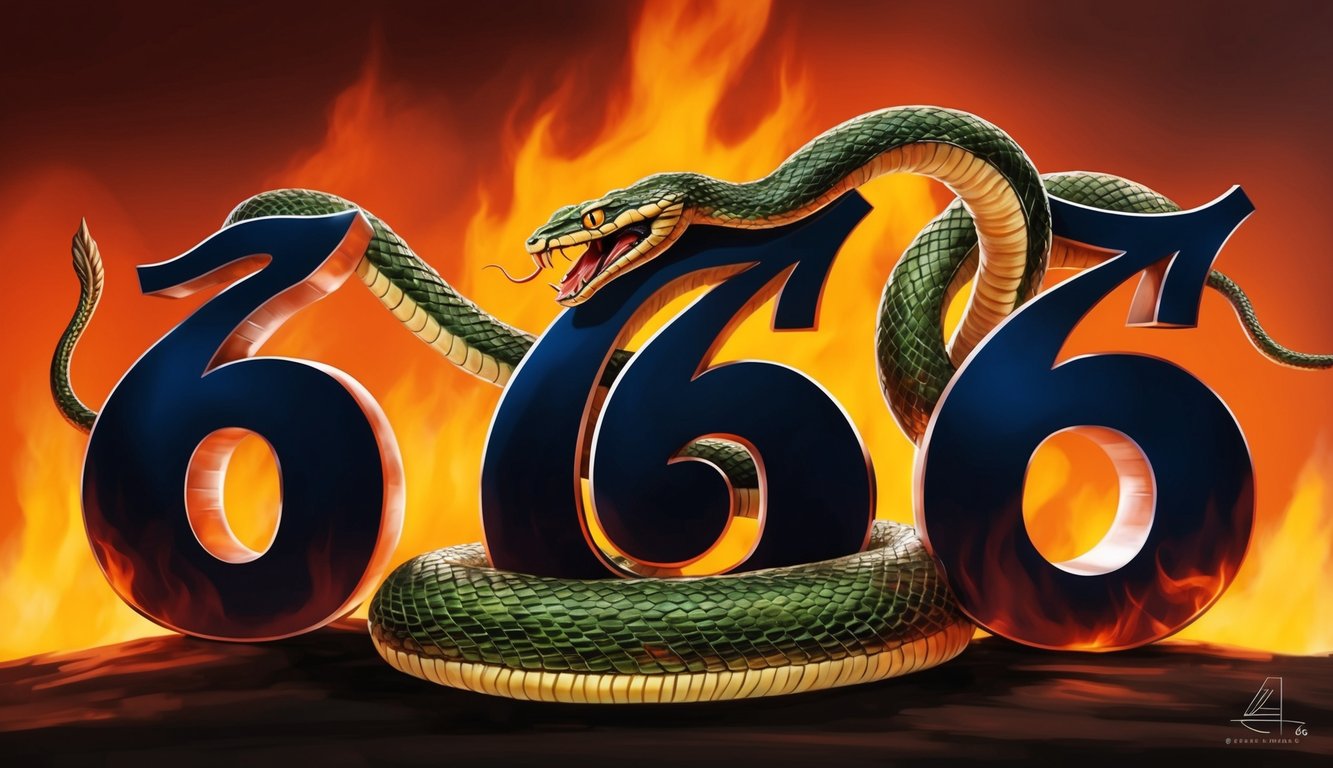Don’t Miss Out On This Unique Astrological Opportunity
Are you tired of spinning your wheels and getting nowhere? Simply put, you’re out of sync: you’re out of alignment with your astral configuration.
But: there’s a kind of map that can help you reclaim your alignment. Think of it as your own personal blueprint to success and happiness: a blueprint that will help you live your most amazing life.
Get started here.
The concept of the “Mark of the Beast” has intrigued many people who study the Bible, especially those interested in Revelation and the End Times.
When you hear about the Mark of the Beast, you might think of mysterious symbols or the Antichrist’s role in the future.
According to the Bible, the Mark of the Beast is a symbolic mark mentioned in the Book of Revelation, representing allegiance to the Beast.
The mark is often interpreted as a symbol of opposition to God’s people.
As you explore these scriptures, you’ll find that Revelation describes the Beast as a powerful figure during the End Times, associated with the Antichrist.
This connection leads to various interpretations and discussions about what the mark might be and how it could manifest.
Linking different perspectives with historical interpretations, like those found in analyses of first-century historical context, adds layers to the conversation.
The topic also invites questions about faith and symbolism seen throughout Christian teachings.
You may compare the Mark of the Beast with the Mark of Christ, which some believe can only be seen through faith, as highlighted in analyses exploring such spiritual meanings.
These discussions encourage believers and curious readers alike to consider their interpretations and what these symbols mean for their faith journey.
Biblical Origins and Scriptural References
When you explore the concept of the “Mark of the Beast,” you encounter intriguing themes from the Bible’s Book of Revelation.
This idea, linked to the Number of the Beast and descriptions involving the forehead and right hand, carries deep symbolic meanings and historical roots.
The Book of Revelation
The phrase “Mark of the Beast” originates from the Book of Revelation in the Bible.
Specifically, in Revelation 13:16, it describes how people receive a mark on their forehead or right hand.
This mark is linked with allegiance to the beast, suggesting a divide between followers of divine will and those who turn away.
Central to this text, the Number of the Beast, famously “666,” has intrigued readers for centuries.
You should recognize that the Book of Revelation is apocalyptic literature.
This means it uses vivid imagery and symbolic language, often reflecting the struggles between good and evil.
The text was written by the Apostle John, and it has been central to Christian eschatology.
It provides profound insight into how early Christians viewed the world.
Interpreting the Text
Interpreting the Mark of the Beast involves examining its symbolic meaning.
Scholars believe that the mark signifies loyalty or submission to the powers opposing God.
In ancient times, receiving a mark on one’s forehead or right hand represented ownership or allegiance, hence the fear of taking the mark meant being aligned against divine will.
Many interpretations see this symbolism as representing moral choices rather than physical marks.
The beast itself is seen as a symbol of oppressive forces or corrupt governments.
Some interpretations link the beast to historical figures such as the Roman Emperor Nero, whose reign epitomized tyranny for early Christians.
This perspective emphasizes the battle against these forces.
Others associate the beast with broader themes of corruption and oppression that have appeared throughout history.
Similar to how nephilim giants in ancient legends symbolized chaos and defiance against divine order, the beast represents the enduring struggle between righteousness and tyranny.
This interpretation suggests that such forces are not confined to a single era but recur across different civilizations and beliefs.
Historical Context of Authorship
Understanding the historical context of the Book of Revelation sheds light on its themes.
Written during a time of persecution, likely under Roman rule, this text reflects the struggles faced by early Christians.
The mention of Rome and emperors like Nero highlights this context.
Living under the Roman Empire, Christians faced pressures to conform to the state’s demands, which went against their beliefs.
By using familiar, apocalyptic imagery, the Apostle John communicated hope and resilience through his writing.
The book’s references to earlier texts, such as those found in Daniel, connect it deeply with Jewish traditions and provide layers of meaning in its message of awaiting divine justice.
The Number 666
The number 666 is deeply rooted in Christian theology as the “Number of the Beast” from the Book of Revelation.
It carries significant symbolism and has been the subject of various interpretations and speculations over centuries.
Symbolism and Numerology
The number 666 is often associated with evil and imperfection.
In contrast to the number seven, which symbolizes completeness and perfection, 666 falls short, representing the flaws of humanity.
This number ties into the idea of imperfection, showcasing a failure to achieve divine harmony.
Numbers in the Bible frequently carry symbolic meanings, and 666 is no exception.
It is commonly viewed as a reflection of earthly, flawed systems that oppose divine will.
Gematria and the Name of the Beast
In ancient times, people used a system called Gematria, where letters represented numbers.
When we apply this to the name “Nero Caesar,” we find a fascinating connection.
The letters in Nero’s name can be calculated to equal 666, making him a possible candidate for the “Number of Its Name”.
Gematria was a popular method of finding hidden meanings in texts.
This connection makes some people believe that Nero might have been linked or symbolized by this number, presenting him as an imperfect agent of chaos.
Theories and Speculations
The number 666 has sparked numerous theories.
One prominent idea is that it embodies the reign of Nero, an emperor notorious for his persecution of Christians.
Early Christian writer Irenaeus mentioned this theory, supporting the connection between 666 and Nero.
Another theory suggests that the Greek word “Lateinos,” representing the Latin world, matches 666 in Gematria, adding to ideas about Roman authority.
Some interpretations argue that 666 warns against oppressive powers, urging people to recognize these forces through wisdom and understanding.
The Mark and Modern Interpretations

When you think about the “mark of the beast,” it’s important to understand how modern society interprets this biblical concept.
Technological advances, financial systems, and societal views are key areas where this topic continues to evolve.
Technological Advancements
You’ve probably heard discussions linking the “mark of the beast” to modern technology.
This usually involves ideas like computer chips or implants that could be placed under your skin, possibly on your foreheads or hands.
These aren’t just in the realm of fiction; some companies have experimented with microchips for access control or payments.
Barcodes and credit card systems have also been mentioned in these conversations.
Modern technology brings both convenience and concerns.
With advancements, questions arise about privacy and control, echoing concerns related to the biblical narrative.
Financial and Medical Concerns
In financial realms, the “mark” sparks discussions about control and access, like whether people will need a specific mark tied to digital currencies or banking systems.
People worry about a future where access to finances depends on identification methods like implants or barcodes.
In the medical field, the idea of a “mark” could relate to mandatory medical implants or records.
Here, concerns often focus on privacy, consent, and ethical issues.
While technology can provide benefits like easier medical tracking, it’s vital to consider the implications.
Cultural and Societal Impact
The “mark of the beast” has cultural and societal implications.
It’s featured in media and literature, influencing how communities perceive technological and governmental developments in the EU, UK, and beyond.
Religious practices like observing the Sabbath come up in these discussions.
There’s debate on whether shifts in society could affect religious freedom or practice.
The cultural impact extends to how communities interact with modern systems, reflecting the balance between adaptation and maintaining traditions tied to identity and belief systems.
Theological Perspectives and Debates

Exploring the “mark of the beast” involves understanding various Christian interpretations that offer insights into the nature of the biblical text.
Key concepts include the interpretation of symbols, the focus on worship and allegiance, and the role of prophecy in end-time events.
Views on Literal vs Symbolic
In discussions about the “mark of the beast,” some view it as a literal mark, possibly a physical symbol of allegiance to the Antichrist.
This perspective suggests that individuals will be physically marked, showing their loyalty to the forces opposed to God.
Others see the mark as symbolic, representing spiritual choices and internal commitments.
This symbolic interpretation emphasizes the battle between good and evil in the heart and soul, rather than on the skin.
The role of the Holy Spirit, guiding believers to discern truth, plays a significant part here.
Understanding these two views helps you grasp the diversity within Christian thought and how believers interpret challenging apocalyptic scripture.
Significance of Worship and Allegiance
Worship and allegiance are central themes connected to the “mark of the beast.” The Bible often highlights the choice between following Jesus Christ or the Dragon, including the rejection of false prophets.
The “mark” signifies a person’s decision to either follow the Lamb and receive the Seal of God, or turn away in disobedience.
Thus, allegiance is not merely outward but deeply tied to how one aligns their life with God’s commandments.
Worship reflects inner beliefs and values, offering a pathway to eternal life through a life of repentance and commitment.
End-Time Prophecies
End-time prophecies narrate cosmic events involving the final showdown between good and evil.
The “mark of the beast” is a critical element in these narratives, suggesting a time when Antichrists and false prophets will rise to deceive many.
Prophecy often speaks of the eventual triumph of God’s kingdom, where those who remain faithful to Jesus Christ will prevail.
The narratives encourage believers to remain vigilant, observing the signs and staying true to their faith.
These prophecies serve as a reminder of the spiritual warfare believers face, urging them to trust in the promises of God and stay aligned with His will.
Engaging with these prophecies helps you prepare spiritually, guiding your understanding of the anticipated events in Christian eschatology.
Cultural References and Artistic Representations

In this section, you’ll explore how the “mark of the beast” has been depicted across various forms of creative expression.
From literature and media to art and political discourse, the mark draws on intriguing connections to both biblical interpretations and imaginative representations.
Literature and Popular Media
The “mark of the beast” is a powerful symbol in literature and popular media.
Writers and filmmakers have used it to convey ideas about identity and transformation.
Rudyard Kipling’s story, The Mark of the Beast, deals with themes of colonialism and cultural misunderstanding.
In modern times, this mark appears in science fiction and horror genres, often tied to dark or dystopian futures.
These narratives sometimes link it to Satanic elements, casting it as a warning against evil.
The symbolic weight of the mark makes it adaptable for different storytelling purposes, from allegory to social critique.
Art and Iconography
In art, the “mark of the beast” often draws inspiration from religious and mythological traditions.
Some artists explore the concept by depicting it as a tattoo or brand, resonating with ideas of ownership and identity.
These images might feature motifs like lions or other powerful animals, reflecting strength or danger.
Illustrations of the mark can incorporate elements from ancient cultures, using symbols that evoke empires or divine punishment.
Biblical themes combine with creative imagination, resulting in eye-catching artworks that challenge viewers to think about faith and morality.
Social and Political Usage
The “mark of the beast” occasionally appears in social and political contexts, often as a metaphor for control or oppression.
Discussions around government surveillance or loss of personal freedoms sometimes evoke this imagery.
Historically, branding or marking represented power dynamics, echoing the empire’s domination or the fate of martyred individuals.
In some narratives, the mark serves as a symbol of rebellion against perceived tyranny, contrasting with the oppressive forces symbolized by Babylon.
This complex interplay of symbols highlights ongoing debates about authority and resistance, making it a potent tool in critiquing contemporary issues.



